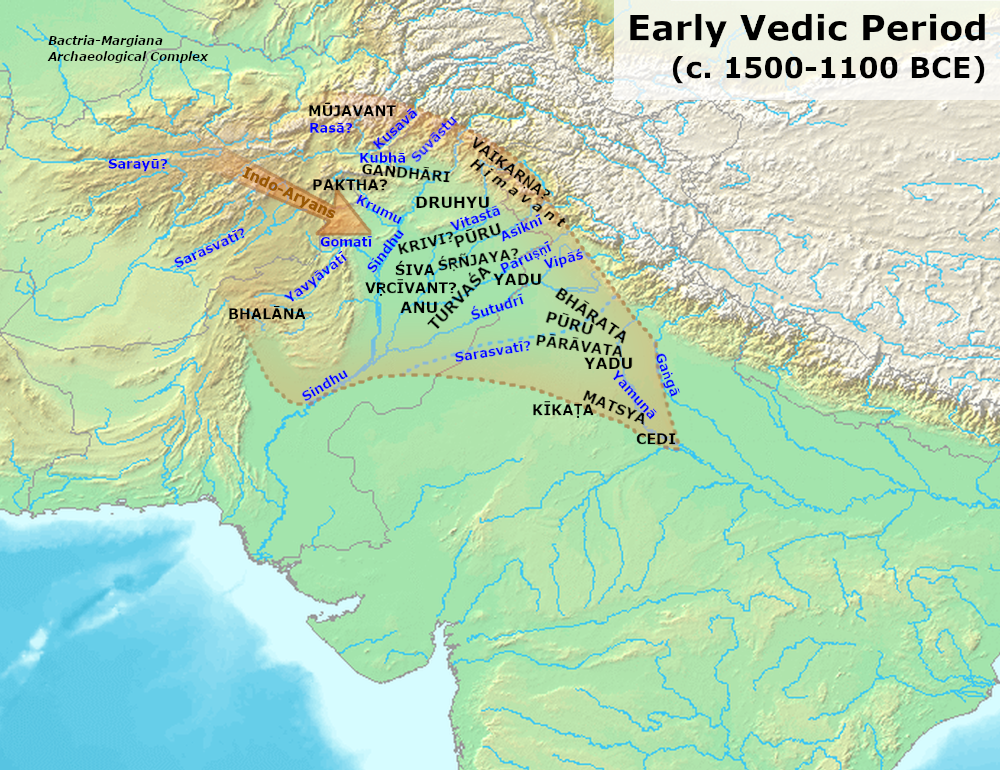Discussion of Geography and sacrifices of Vedic age by Harsh Kumar
The Vedic age was one of the most important of the Indian History which flourished for around 1000 years before the advent of the Mahajanpada in Indian subcontinent. We have already discussed about various aspects of the Vedic age like political, social, economic and religious in our previous blogs, you can also them from link below. In this post we going to discuss about the geographical knowledge, role of sacrifices and living patterns of the Vedic peoples.
Read Also : Vedic Age – The Religious Life
Vedic Age – Origin and Political Life
Geographical Knowledge of Vedic Aryans
The references found in Rig Veda Samhita helped in understanding the geographical knowledge of Early Vedic Aryans. The names of various rivers and other elements helped in understanding the geographical knowledge of Vedic Aryans. After entering in Indian subcontinent, Aryans got settle in Sapta-Sindhva region, the land of seven rivers. They were probably talking about the River Indus and its Five tributaries (Ravi, Jhelum, Chenab, Beas and Sutlej), and River Saraswati.

These references indicates that they were living in the region of Rajasthan and Punjab. River Saraswati was mentioned about 72 times which indicates that they were living mostly around this river. River Yamuna was mentioned twice and Ganges only once, which indicates that these rivers were not so important during the Vedic age. Brahamavarta region is mentioned as the geographical area of Early Vedic Aryans.
Thus, the land lies between the river Sutlej and river Yamuna. Tiger was not mentioned by them which suggests that they were not reached to eastern forest on India yet. They were aware of the Himalayas as they procured the Soma plant which was available on the Mujvanta peak of Himalayas. The word Samudra was mentioned by the Vedic Aryans but it was referred to the huge amount of water they have seen in the rivers of northern plains.

But during the later Vedic age, the culture moved to the eastern part of the subcontinent. Sathapatha Brahmana contains the story of expansion of Vedic culture into east. According to this book, Prince Videghamadhava accompanied by hic priest Gautama Rahugana cleared the forest with the help of God Fire, who stopped after reaching River Sadanira (Gandhak) as they proclaimed the area west to this is suitable for Vedic Aryans.
Atharvaveda contains references of the tribes living in eastern part like Anga and Magadha. They mentioned the eastern and western seas which indicates that they were aware of Bay of Bengal and Arabian Sea. The Vindhayas were mentioned in Kaushitek Upanishad. Aiteriya Brahmana contain reference of five-fold division of India namely Prachya (eastern part), Pratichya (western part), Utrapatha (northern region), Dhruvamadhyamandis (Central India) and Tamilham (southern part).
Significance of Sacrifices during the Vedic age
The sacrifices played a significant during the Vedic age. They were simple and easy to perform in early Vedic age but over the time these sacrifices were become complex and costly, in later Vedic age. Thus, only elite class able to perform them with the help of priests. It was a proper institution during the Vedic age in which producers and non-producing sections of the society participated.
Sacrifices were performed by the householders and kings. The householders who performed sacrifices were mainly peasants, merchants, traders and craftsmen. Whenever a sacrifice was performed, the householder (Yajmana) used to give gifts to priest conducting the sacrifice. This process used to result in exchange of resources between producing class and non-producing class of priests.
The same process was followed when the kings performed the sacrifices, the only difference was in donations made was kings were larger in amount as they own more than ordinary peoples of state. As the economy of Vedic age got prospered that result in availability of resources which ultimately result in expansion of the sacrifice processes. The complex and costly sacrifices like Ashwamedha, Rajasuya and Vajapaya were the examples of the same.
The sacrifices like Ashwamedha, Rajasuya and Vajapaya were have political significance. The Rajasuya sacrifice (coronation ceremony) was performed to enhanced the prestige of crown while appointing new king. Vajapaya was performed to increase the strength of the King. The Ashwamedha was performed to increase the territorial extent of the state.
Thus, the Vedic texts through light on the significant elements of the geography and significance of sacrifices during the Vedic age which provides us beneficial inputs to understand the history of Vedic Aryans more effectively.

Pingback: Vedic Age – Iron and Pattern of Living - historylover.in